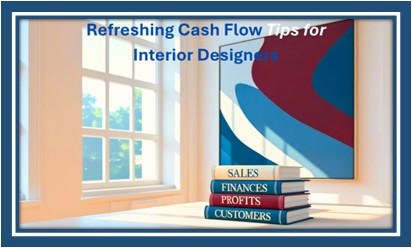
Cash Flow Management Tips for our Creative Interior Designer Clients
Interior design is a profession that seamlessly blends creativity and practicality. While an eye for design, and an understanding of spatial aesthetics are essential to your business, successful interior designers also require robust business and financial skills to maintain a thriving business with positive Cash flow to meet your business and personal financial goals.
Interior designers face unique challenges in cash flow management due to the nature of their projects. These challenges include:
- Project-Based Revenue: Payments often depend on project completions, which can lead to progress billing and irregular income streams.
- High Upfront Costs: Designers often need to purchase materials, furniture, and decor before receiving payment from clients.
- Client Payment Delays: Late payments from clients can further exacerbate cash flow issues, leaving designers struggling to cover their expenses.
- Seasonal Demand: The interior design industry often experiences seasonal fluctuations, with more demand during certain times of the year and lulls in others.
Strategies for Effective Cash Flow Management
1. Develop a Detailed Budget
A budget provides a clear overview of your financial situation and helps you make informed decisions on allocating expenses based upon projected revenues. A well-planned budget is the cornerstone of effective cash flow management.
2. Implement a Retainer or Milestone Progress Billings System
One of the best ways to mitigate cash flow issues is to structure your payment terms. Instead of waiting for full payment at the end of a project, break it into milestones:
- Initial Deposit: Secure a percentage upfront before starting the project to cover preliminary expenses.
- Progress Payments: Request payments at key stages of the project, such as after the design concept is approved or once construction begins.
- Final Payment: Collect the remaining balance upon project completion.
This approach ensures a steady stream of income and reduces the financial burden on your business.
3. Set Aside an Emergency Fund
Set aside a portion of your earnings into an emergency fund to build a reserve that can sustain your business for at least three to six months. Having a financial cushion ensures that you can weather unexpected expenses or periods of sluggish revenue without jeopardizing your operations.
4. Negotiate Payment Terms with Clients and Vendors
Don’t hesitate to negotiate payment terms that work in your favor. For clients, establish clear payment expectations in your contracts and consider upfront deposits, early-payment discounts, or late-payment penalties. For vendors, explore options like extended payment terms or bulk discounts when purchasing frequently used materials.
5. Monitor and Reduce Overheads
Regularly review your overhead costs to identify areas where you can decrease costs and alleviate cash flow pressures.
6. Implement an Effective Accounting Solution
Modern accounting software, such as QuickBooks Online, can be a game-changer by helping you track income and expenses, monitor Accounts Receivable, monitor outstanding payments, and track your cash balance. However, outsourced accounting and bookkeeping for interior designers can provide insights into the overall financial health of your business while providing suggestions to reduce costs and insights into your most profitable projects and customers. Let’s Talk ! Book a Virtual Meeting!
7. Cash Flow Forecast
A cash flow forecast is like a budget in that it estimates incoming cash and outgoing cash based on past performance, factoring in current economic and business conditions. It aims to help your company minimize the impact of a cash shortage by being proactive in mitigating potential issues during an economic period where costs are rising due to increased materials costs from tariffs or slow payments from customers due to rising interest rates. It may be helpful to forecast future cash flows for 3, 6, or 12 months. Contact us for our Controller and CFO services today!
Conclusion:
As an interior designer, your creative vision is your greatest asset! By implementing the strategies outlined in this guide (budgeting, structuring customer payments, and cash flow forecasting) your business can better navigate financial challenges and maintain steady cash flow so you can focus on doing what you love: designing beautiful spaces that inspire and transform living spaces!
